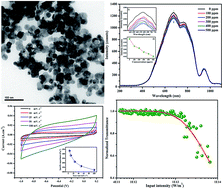Size–strain distribution analysis of SnO2 nanoparticles and their multifunctional applications as fiber optic gas sensors, supercapacitors and optical limiters†
Abstract
SnO2 nanoparticles (NPs) were prepared by a wet chemical method and characterized by X-ray diffraction (XRD) (rutile tetragonal), Fourier transform infrared spectroscopy (FTIR) (Sn–O, 657 cm−1) and micro Raman spectroscopy (Sn–O, 635 cm−1). From X-ray peak broadening analysis, the crystallite size, lattice strain, deformation stress and energy density values of the tetragonal SnO2 NPs were calculated by modified Williamson–Hall analysis and the size strain plot method. From high resolution transmission electron microscopy (HRTEM), the measured average particle size was determined to be 24 nm. The bandgap was estimated by the Tauc relation as 3.51 eV from UV-visible (UV-vis) spectra. The photoluminescence (PL) spectrum reveals emissions at 382, 416, 440 and 487 nm due to the presence of oxygen defects. Frequency-dependent (42 Hz to 5 MHz) and temperature-dependent (303 to 423 K) electrical properties, such as dielectric constant, loss tangent, AC conductivity and electric modulus, were evaluated by impedance spectroscopy. A SnO2 NPs-clad modified fiber optic gas sensor was used to detect ammonia gas (0 to 500 ppm). The electrochemical performance of the SnO2 NPs electrode has been analyzed by cyclic voltammetry (CV) and galvanostatic charge–discharge (GCD) measurements. Optical limiting measurements for the SnO2 NPs were carried out using a Nd:YAG laser (532 nm, 5 ns, 10 Hz).


 Please wait while we load your content...
Please wait while we load your content...